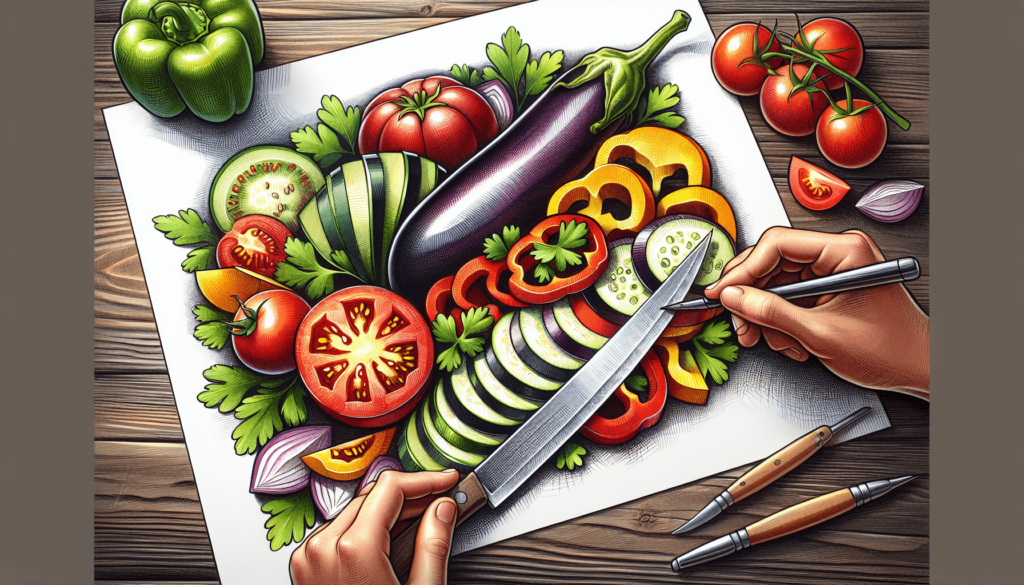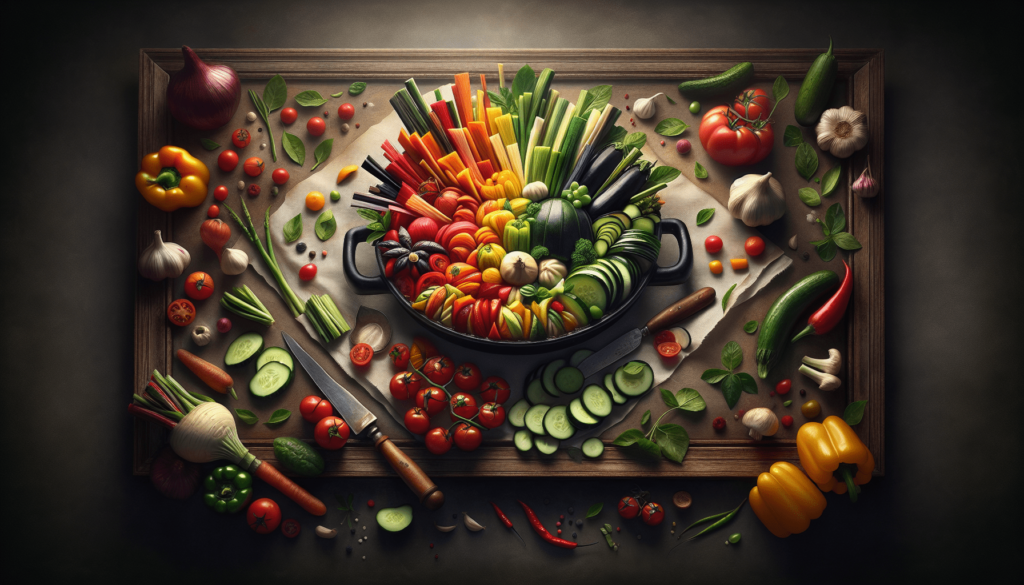You’re about to embark on a delectable journey into the visual feast that is “The Art of Ratatouille.” Get ready to be whisked away to the charming streets of Paris, where our little rat protagonist, Remy, takes us on a culinary adventure like no other. From the vibrant colors of the vegetable markets to the mouthwatering details of each dish, this article will immerse you in the art and beauty that brings this beloved Pixar film to life.
History of Ratatouille
Origin of Ratatouille
Ratatouille, a classic French vegetable dish, has a rich and interesting history that dates back centuries. While its exact origins are debated, ratatouille is believed to have originated in the Nice region of France. It was initially a peasant dish, born out of necessity and the need to make the most of the available ingredients.
Traditional Recipe
The traditional recipe for ratatouille consists of a medley of fresh vegetables, such as tomatoes, zucchini, eggplant, bell peppers, and onions, cooked with a variety of herbs and spices. This dish is known for its simplicity and rustic charm, allowing the natural flavors of the vegetables to shine through.
Ingredients for Ratatouille
Vegetables
To make a delicious ratatouille, you will need a selection of fresh and vibrant vegetables. Tomatoes are an essential ingredient, as they form the base of the dish. Zucchini, eggplant, bell peppers, and onions are also commonly used, but feel free to experiment with other vegetables like yellow squash or even mushrooms.
Herbs and Spices
When it comes to herbs and spices, you have plenty of options to add depth and flavor to your ratatouille. Traditional herbs like thyme, rosemary, and bay leaves infuse the dish with a fragrant aroma. Garlic and basil are also crucial for enhancing the taste profile.
Cooking Oil
To cook the vegetables and prevent them from sticking, a cooking oil of your choice is needed. Olive oil is the most commonly used oil in ratatouille, adding a rich and distinctive taste. However, feel free to use other oils, such as vegetable or sunflower oil, depending on your preference.

Preparing the Vegetables
Choosing the Right Vegetables
When selecting vegetables for your ratatouille, it’s essential to choose ones that are ripe, firm, and free from any blemishes. Look for vibrant colors and a fresh appearance to ensure the best flavor in your dish.
Washing and Cutting Techniques
Before you start cooking, make sure to wash the vegetables thoroughly to remove any dirt or debris. When it comes to cutting the vegetables, aim for uniform slices or cubes. This not only ensures even cooking but also adds an appealing visual element to your ratatouille.
Cooking Techniques
Sautéing
Sautéing is a popular method for cooking ratatouille. Start by heating the oil in a large pan or skillet over medium heat. Add the vegetables, starting with the onions, and cook them until they begin to soften. Gradually add the rest of the vegetables, allowing each one to cook slightly before adding the next. This method allows the flavors to meld together while maintaining the distinct texture of each vegetable.
Baking
Baking ratatouille in the oven is another fantastic option that results in a flavorful and tender dish. Arrange the vegetables in a baking dish, drizzle with olive oil, and sprinkle with herbs and spices. Bake at a moderate temperature, around 375°F (190°C), until the vegetables are cooked through and slightly caramelized. This method intensifies the flavors and creates a delightful depth of taste.
Slow Cooker Method
For those who prefer a hands-off approach, the slow cooker method is an excellent choice. Simply place all the prepped vegetables into the slow cooker, add herbs and spices, and cook on low heat for several hours. This slow cooking process allows the flavors to develop and meld together, resulting in a rich and aromatic ratatouille.

Flavor Enhancements
Garlic and Onion
Garlic and onion play a pivotal role in enhancing the flavors of ratatouille. Their aromatic properties infuse the dish with a savory depth. The onions provide natural sweetness, while the garlic adds a punch of flavor. Try using fresh garlic and sautéing it before adding the vegetables to maximize its taste potential.
Herbs and Spices
Herbs and spices are crucial in adding complexity and depth to ratatouille. Traditional herbs like thyme, rosemary, and bay leaves bring a fragrant aroma, while basil adds a fresh and vibrant taste. Feel free to experiment with other herbs and spices, such as oregano or red pepper flakes, to add your unique twist to the dish.
Serving Suggestions
Accompaniments
Ratatouille can be enjoyed as a standalone dish or paired with various accompaniments to create a complete and satisfying meal. Serve it alongside crusty bread or fluffy couscous to soak up the delicious juices. For a heartier option, consider serving it with grilled chicken, fish, or even pasta for a delightful and well-rounded dinner.
Garnish Options
To add an appealing visual touch and flavor burst, consider garnishing your ratatouille with fresh herbs like parsley or basil. A sprinkle of Parmesan cheese or a drizzle of balsamic glaze can also elevate the presentation and taste of the dish. Get creative and experiment with different garnishes to make your ratatouille truly shine.
Variations of Ratatouille
Ratatouille Niçoise
Ratatouille Niçoise is a variation that originated in the Provence region of France, specifically in the city of Nice. It typically includes additional ingredients like olives, capers, and sometimes anchovies. These additions add a briny and tangy element to the dish, creating a unique flavor profile.
Ratatouille Pizza
For a fun and unconventional twist, turn your ratatouille into a delicious pizza topping. Spread a thin layer of tomato sauce or pesto on a pizza crust, and then generously pile on the ratatouille. Top it off with mozzarella cheese and any other desired toppings, and bake it in the oven until the cheese is melted and bubbly. Ratatouille pizza combines the best of both worlds, marrying the flavors of the Mediterranean with the comfort of pizza.
Grilled Ratatouille Kabobs
Grilled ratatouille kabobs are a perfect option for outdoor barbecues or summer gatherings. Cut the vegetables into chunks, thread them onto skewers, and brush them with olive oil and your preferred seasonings. Grill the kabobs over medium heat until the vegetables are tender and slightly charred. This variation adds a smoky flavor to the ratatouille, making it a crowd-pleasing and visually appealing dish.
Ratatouille in Popular Culture
The Disney Pixar Movie Ratatouille
Ratatouille gained widespread recognition and popularity through its appearance in the Disney Pixar movie of the same name. The animated film follows the journey of a young rat named Remy, who aspires to become a great chef. The movie showcases the beauty and artistry of cooking, with ratatouille taking center stage as a symbol of culinary excellence.
Influences in Culinary World
Ratatouille’s presence in popular culture has had a significant influence on the culinary world. It has sparked an increased interest in French cuisine and shed light on the importance of using fresh and seasonal ingredients. Chefs around the world have incorporated ratatouille-inspired elements into their dishes, embracing its rustic charm and celebration of vibrant flavors.
Health Benefits of Ratatouille
High Nutritional Value
Ratatouille is not only a flavorful dish but also offers a range of health benefits. Packed with an array of vegetables, it provides essential vitamins, minerals, and antioxidants. It is an excellent source of dietary fiber, potassium, and vitamin C, contributing to a well-balanced and nutritious diet.
Fiber and Antioxidants
The combination of vegetables in ratatouille provides a substantial amount of dietary fiber, aiding in digestion and promoting a healthy gut. Additionally, the vegetables’ vibrant colors indicate a high antioxidant content, which helps protect cells against damage and boosts the immune system.
Supporting Overall Health
With its nutritious ingredients, ratatouille has been linked to numerous health benefits. Regular consumption of this vegetable medley may assist in maintaining a healthy weight, reducing the risk of chronic diseases such as heart disease and certain types of cancer, and supporting overall well-being.
Tips and Tricks
Batch Cooking and Freezing
Ratatouille is a versatile dish that lends itself well to batch cooking and freezing. Make a larger quantity than needed and store the leftovers in an airtight container in the refrigerator or freezer. This way, you can enjoy the flavors of ratatouille with minimal effort on busy days. When reheating, gently heat it on the stovetop to preserve the texture and flavors.
Creative Leftovers
If you find yourself with leftover ratatouille, don’t let it go to waste. Get creative and repurpose it into other delicious meals. Use it as a topping for bruschetta, mix it into pasta or rice dishes, or stuff it into sandwiches or wraps for a flavorful and convenient lunch. The possibilities are endless when it comes to reinventing ratatouille leftovers.
Ratatouille is a timeless dish that transcends borders and has captured the hearts of people around the world. Its humble beginnings as a peasant dish have evolved into a cherished culinary creation that celebrates freshness, simplicity, and the beauty of seasonal vegetables. Whether you enjoy it as a standalone dish, get inventive with variations, or embrace its appearance in popular culture, ratatouille is sure to bring joy and deliciousness to anyone’s table. So, grab your pots, pans, and fresh vegetables, and embark on a culinary journey through the flavors and history of ratatouille.
